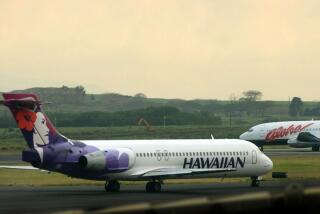U.S. Airlines Look to Asia for Room to Expand
- Share via
SAN FRANCISCO — When American Airlines begins nonstop service from Texas to Tokyo next summer, yet another U.S. carrier will have made a strategic move into the vast and growing Pacific market that lies beyond Hawaii.
The Dallas-based airline is “bullish about the growth prospects of the entire Pacific Basin,” Wesley G. Kaldahl, American’s senior vice president for airline planning, told executives at a conference here on civil aviation.
American sees “enormous long-term growth potential and economic and social trends that favor the travel industry” in the Pacific area, Kaldahl explained. “American believes that the best is yet to come in the Pacific--and we are determined to be a strong competitive factor in the Pacific as this growth occurs over the next 10 to 15 years.”
American was awarded one of two U.S.-Tokyo routes made possible by new agreements between the United States and Japan. The second route, from Atlanta to Tokyo via Portland, Ore., was awarded last month to Delta Air Lines.
Clearly, deregulation is creating new opportunities in the Pacific for U.S. carriers. American and Delta will join United, Continental and Northwest, among domestic airlines, along with carriers from Japan, Korea, China and Singapore in spanning the Pacific.
These foreign carriers, under U.S. law, may carry passengers only to an entry point in the United States, not between cities. That right is reserved to domestic carriers, which hope to turn that to their advantage in the Pacific market by providing direct service from Asia to the network of cities that they serve in the United States.
Opening New Markets
American, for example, operates 350 flights a day to 90 nonstop destinations out of the Dallas-Fort Worth hub, where its new Tokyo flights will originate. Kaldahl said these new flights will have convenient connections to and from about half of these cities.
“The American connection at Dallas-Fort Worth will represent the fastest way for local residents to fly to Japan,” he said. “We thus expect to open markets to Japan that do not exist today or that exist in only a very limited fashion.”
U.S. carriers often offer connecting service for only a few dollars more than the transpacific fare--a marketing ploy that foreign carriers, such as Australia’s Qantas Airways, say is unfair. John F. Ward, Qantas’ chief executive, said foreign airlines are at a disadvantage in both pricing and routes, while U.S. carriers “dump” more seating capacity in the Pacific market to position themselves for growth.
By most accounts, the Pacific market is ripe for that growth. Kaldahl said that real gross product is expected to increase about 3% annually worldwide from 1987 to 1995 but by 4.1% in Asia and 4% for Japan alone. Growth in Europe is forecast to increase 2% annually over the same period and in the United States by nearly 3% a year.
Airlines and aircraft manufacturers estimate that travel between the United States and Asia will expand faster than travel to any other part of the world. Traffic over the U.S.-to-Asia routes will grow by 7% to 8% a year through 1990, compared to 5% to 6% for the North Atlantic, Kaldahl said. (European traffic, however, will continue to surpass that shuttling the Pacific, he added.) In addition, U.S. carriers expect greater expansion opportunities in the transpacific market because it now comprises seven countries served by only 11 airlines, compared to a European market in which 14 countries are served by 32 carriers.
U.S. Protectionism Charged
Even with such prospects, however, Pacific skies are becoming clouded by contentious bilateral talks between the United States, on the one hand, and Japan and Australia on the other. Australian air executive Ward maintains that U.S. negotiators are unduly protecting American carriers.
“We want to compete, but on a basis of fairness,” he said.
Mitsunari Kawano, managing director and executive officer of Japan Air Lines, proposed a cooperative effort among Pacific carriers. Under his plan, participating airlines would try to develop a new route network with its hub in Micronesia, from which U.S., Australian, Japanese and other transpacific carriers would operate.
More to Read
Inside the business of entertainment
The Wide Shot brings you news, analysis and insights on everything from streaming wars to production — and what it all means for the future.
You may occasionally receive promotional content from the Los Angeles Times.









